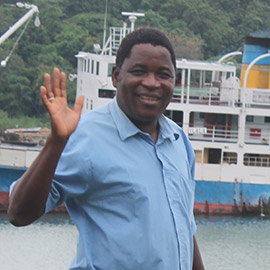Messages from Malawi: Florian visits hard-to-reach Likoma Island
Our Sponsor A School officer Florian recently spent three weeks travelling around Northern Malawi, visiting schools where Mary’s Meals are served. He also spent the night on Likoma Island and in our latest blog, explains why it wasn’t all plain sailing!
Back to all stories | Posted on 11 March 16 in Messages from Malawi
I have lived in Malawi my whole life but never been to Likoma Island. I was going there to collect photographs and children’s stories so we can provide updates to people who sponsor schools where Mary’s Meals are served.
To get to Likoma Island you catch the same boat that takes the likuni phala porridge across Lake Malawi for the feeding programme there.
It was my friend that told me the jetty at Nkhata Bay had collapsed and the ‘llala’ (ship) was docked in the deeper part of the lake, further from the mainland. Passengers had to be ferried to and from the mainland on small boats. I wasn’t sure how I was going to get on the small boat without taking off my shoes.
The people on Likoma Island have to import a lot of their food because the soil is so poor. One night on the boat in heavy wind and rain showed me how challenging importing this food can sometimes be.
When I arrived I found parents and volunteers from all the island’s schools on the shore. Similar to the situation at Nkhata Bay – they were waiting to jump onto small boats to be ferried out to the bigger ship to collect the likuni phala because the water was too choppy to bring the big boat to shore. I was surprised to see the excitement of the people when they saw me carrying my luggage – even without the likuni phala – it must have been my Mary’s Meals t-shirt!
I had expected to find a vehicle waiting for me but to my surprise I could not see any roads on the island. McDonald (Mary’s Meals regional manager for Northern Malawi) and I walked to St Peter’s Primary School through small rocky paths. I would say 80% of the island is covered in rocks and most of the buildings are built with stones. As a farmer myself, that made me wonder: ‘how do people of the island farm for their living?’
It’s a big challenge to move between the schools because of the poor and rocky paths. Movement of the food from the ship to the schools is another challenge. I was told that the people of Likoma Island mainly depend on fishing as their main source of generating income for their living. These are just some of the reasons why the Mary’s Meals feeding programme is so important to the community.
We all need food to live. The feeding programme is serving a great need for the children of the island and I’m happy that Mary’s Meals is there. I would meet children going to and from school or going fishing at the lake. I didn’t see any child just roaming around, the children are encouraged and attracted to attend school because of the programme.
I think the feeding programme has shown great change both to the parents and children on the island. When children wake up in the morning they already have hope that at least they will have a meal at school and parents push their children to go school so that they get a daily meal.
I spent all of my time on Likoma Island speaking to the children, teachers and volunteers so that I have lots of information to share with Mary’s Meals’ supporters who sponsor these schools. I love my job very much because I have the opportunity to see various new places which I would have never seen if I wasn’t in this job. I like interviewing and talking to people and it is through this that I get to know and understand how other people are struggling with life. I enjoy mixing with all kinds of people so I love my work!
Find out what's going on at Mary's Meals.
